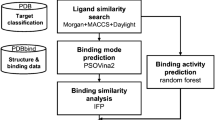Abstract
Because of advances in the high-throughput screening technology, identification of a hit that can bind to a target protein has become a relatively easy task; however, in the process of drug discovery, the following hit-to-lead and lead optimization still remain challenging. In a typical hit-to-lead and lead optimization process, the analogues of the most promising hits are synthesized for the development of structure–activity relationship (SAR) analysis, and in turn, in the effort of optimization of lead compounds, such analysis provides guidance for the further synthesis. The synthesis processes are usually long and labor-intensive. In silico searching has becoming an alternative approach to explore SAR especially with millions of compounds ready to be screened and most of them can be easily obtained. Here, we report our discovery of 15 new Dishevelled PDZ domain inhibitors by using such an approach. In our studies, we first developed a pharmacophore model based on NSC668036, an inhibitor previously identified in our laboratory; based on the model, we then screened the ChemDiv database by using an algorithm that combines similarity search and docking procedures; finally, we selected potent inhibitors based on docking analysis and examined them by using NMR spectroscopy. NMR experiments showed that all the 15 compounds we chose bound to the PDZ domain tighter than NSC668036.







Similar content being viewed by others
Abbreviations
- Dvl:
-
Dishevelled
- HSQC:
-
Heteronuclear single quantum coherence
- NCI:
-
National Cancer Institute
- NMR:
-
Nuclear magnetic resonance
- PDZ:
-
Post-synaptic density-95/discs large/zonula occludens-1
- SAR:
-
Structure–activity relationship
References
Burbaum J, Sigal N (1997) Curr Opin Chem Biol 1:72. doi:10.1016/S1367-5931(97)80111-1
Liu B, Li S, Hu J (2004) Am J Pharmacogenomics 4:263. doi:10.2165/00129785-200404040-00006
Bleicher K, Böhm H, Müller K, Alanine A (2003) Nat Rev Drug Discov 2:369. doi:10.1038/nrd1086
Keseru G, Makara G (2006) Drug Discov Today 11:741. doi:10.1016/j.drudis.2006.06.016
Irwin J, Shoichet B (2005) J Chem Inf Model 45:177. doi:10.1021/ci049714+
Hann M, Oprea T (2004) Curr Opin Chem Biol 8:255. doi:10.1016/j.cbpa.2004.04.003
Shan J, Shi D, Wang J, Zheng J (2005) Biochemistry 44:15495. doi:10.1021/bi0512602
Dev K (2004) Nat Rev Drug Discov 3:1047. doi:10.1038/nrd1578
Fry D, Vassilev L (2005) J Mol Med 83:955. doi:10.1007/s00109-005-0705-x
Fujii N, Haresco J, Novak K, Stokoe D, Kuntz I, Guy R (2003) J Am Chem Soc 125:12074. doi:10.1021/ja035540l
Fujii N, You L, Xu Z, Uematsu K, Shan J, He B et al (2007) Cancer Res 67:573. doi:10.1158/0008-5472.CAN-06-2726
Joshi M, Vargas C, Boisguerin P, Diehl A, Krause G, Schmieder P et al (2006) Angew Chem Int Ed Engl 45:3790. doi:10.1002/anie.200503965
Barker N, Clevers H (2006) Nat Rev Drug Discov 5:997. doi:10.1038/nrd2154
Wolber G, Langer T (2005) J Chem Inf Model 45:160. doi:10.1021/ci049885e
Cheyette B, Waxman J, Miller J, Takemaru K, Sheldahl L, Khlebtsova N et al (2002) Dev Cell 2:449. doi:10.1016/S1534-5807(02)00140-5
Kramer B, Rarey M, Lengauer T (1999) Proteins 37:228. doi:10.1002/(SICI)1097-0134(19991101)37:2<228::AID-PROT8>3.0.CO;2-8
Friesner R, Banks J, Murphy R, Halgren T, Klicic J, Mainz D et al (2004) J Med Chem 47:1739. doi:10.1021/jm0306430
London T, Lee H, Shao Y, Zheng J (2004) Biochem Biophys Res Commun 322:326. doi:10.1016/j.bbrc.2004.07.113
Wong H, Bourdelas A, Krauss A, Lee H, Shao Y, Wu D et al (2003) Mol Cell 12:1251. doi:10.1016/S1097-2765(03)00427-1
Delaglio F, Grzesiek S, Vuister G, Zhu G, Pfeifer J, Bax A (1995) J Biomol NMR 6:277. doi:10.1007/BF00197809
Goddard TD, Kneller DG, SPARKY 3. University of California, San Francisco. http://www.cgl.ucsf.edu/home/sparky/
Worrall J, Reinle W, Bernhardt R, Ubbink M (2003) Biochemistry 42:7068. doi:10.1021/bi0342968
Gund P (1977) Prog Mol Subcell Biol 5:17
Guner OF (2000) Pharmacophore perception, development, and use in drug design. International University Line, La Jolla
Langer T, Hoffmann RD (2006) Pharmacophores and pharmacophore searches. Wiley-VCH, Weinheim
Zerbe O (2003) BioNMR in drug research (methods and principles in medicinal chemistry), vol 16. Wiley-VCH, Weinheim
Hammond M, Harris B, Lim W, Bartlett P (2006) Chem Biol 13:1247. doi:10.1016/j.chembiol.2006.11.010
Wallace A, Laskowski R, Thornton J (1995) Protein Eng 8:127. doi:10.1093/protein/8.2.127
Acknowledgments
We thank the Protein Production Facility at St. Jude Children’s Research Hospital and Dr. Ho-Jin Lee, Youming Shao for producing proteins, Dr. Weixing Zhang for his assistance with NMR experiments, Dr. Charles Ross and Scott Malone for their computer support. This work is supported by grants CA21765 and GM061739. We are grateful to the American Heart Association for a Predoctoral Fellowship to J. Shan.
Author information
Authors and Affiliations
Corresponding author
Rights and permissions
About this article
Cite this article
Shan, J., Zheng, J.J. Optimizing Dvl PDZ domain inhibitor by exploring chemical space. J Comput Aided Mol Des 23, 37–47 (2009). https://doi.org/10.1007/s10822-008-9236-1
Received:
Accepted:
Published:
Issue Date:
DOI: https://doi.org/10.1007/s10822-008-9236-1




